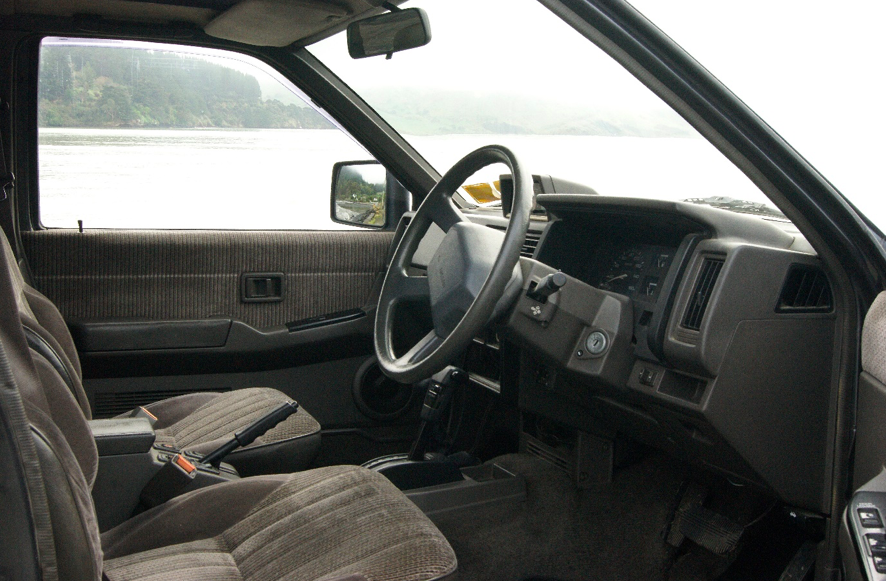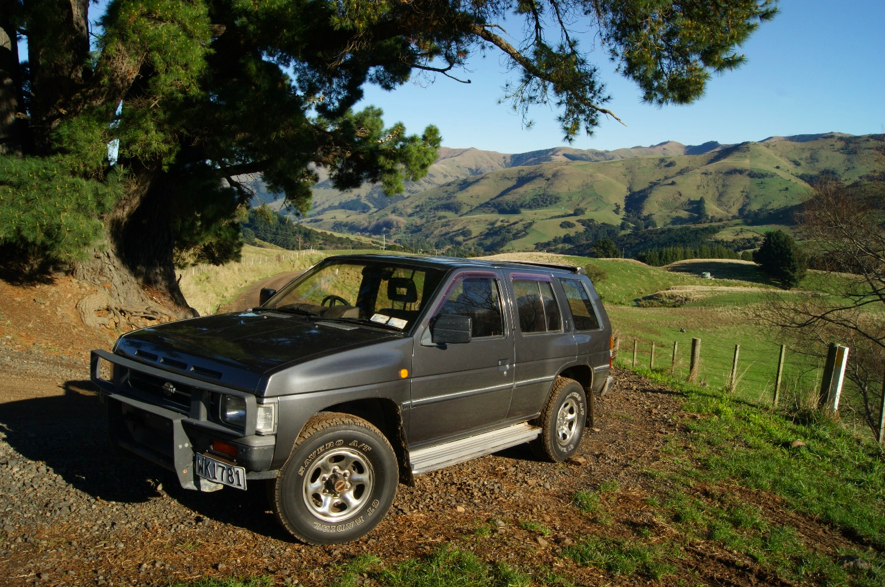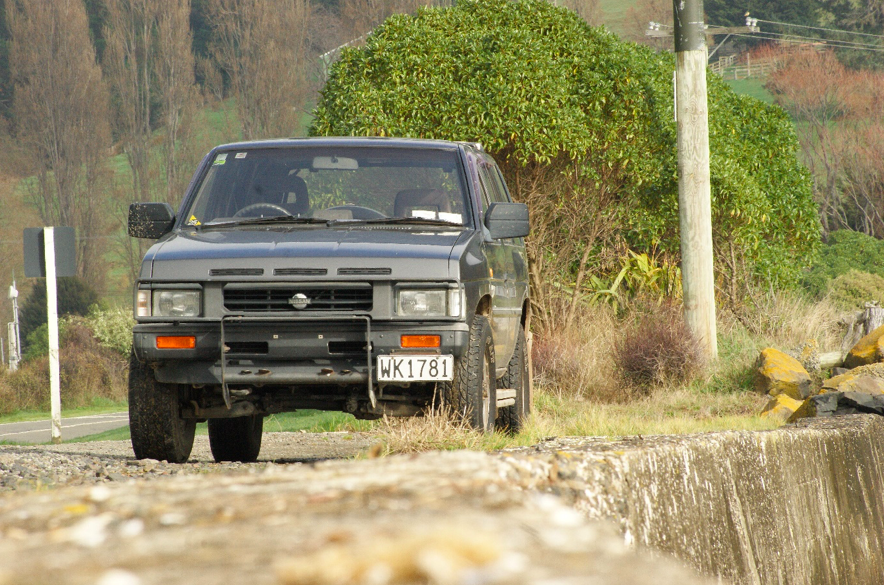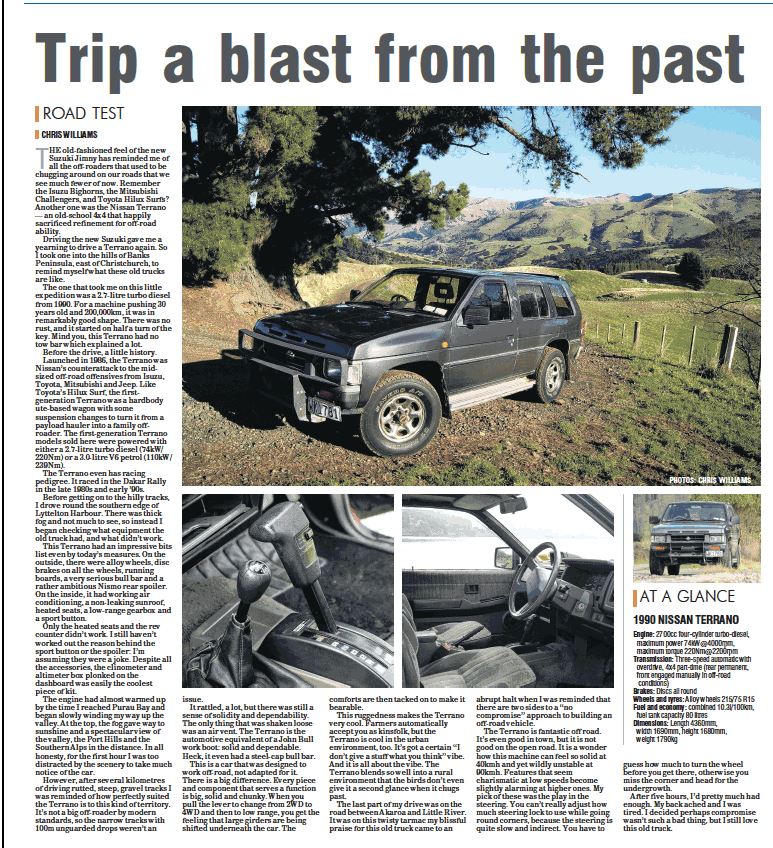Nissan Terrano: Trip A Blast From The Past
The old-fashioned feel of the new Suzuki Jimny has reminded me of all the off-roaders that used to be chugging around on our roads that we see much fewer of now. Remember the Isuzu Bighorns, the Mitsubishi Challengers, and Toyota Hilux Surfs? Another one was the Nissan Terrano — an old-school 4×4 that happily sacrificed refinement for off-road ability.
Driving the new Suzuki gave me a yearning to drive a Terrano again. So I took one into the hills of Banks Peninsula,east of Christchurch, to remind myself what these old trucks are like.
The one that took me on this little expedition was a 2.7-litre turbo diesel from 1990. For a machine pushing 30 years old and 200,000km, it was in remarkably good shape. There was no rust, and it started on half a turn of the key. Mind you, this Terrano had no tow bar which explained a lot.
Before the drive, a little history.
Launched in 1986, the Terrano was Nissan’s counterattack to the midsized off-road offensives from Isuzu, Toyota, Mitsubishi and Jeep. Like Toyota’s Hilux Surf, the first generation Terrano was a hardbody ute-based wagon with some suspension changes to turn it from a payload hauler into a family off-roader. The first-generation Terrano models sold here were powered with either a 2.7-litre turbo diesel (74kW/ 220Nm) or a 3.0-litre V6 petrol (110kW/ 239Nm).
The Terrano even has racing pedigree. It raced in the Dakar Rally in the late 1980s and early ’90s.
Before getting on to the hilly tracks, I drove round the southern edge of Lyttelton Harbour. There was thick fog and not much to see, so instead I began checking what equipment the old truck had, and what didn’t work.
This Terrano had an impressive bits list even by today’s measures. On the outside, there were alloy wheels, disc brakes on all the wheels, running boards, a very serious bull bar and a rather ambitious Nismo rear spoiler. On the inside, it had working air conditioning, a non-leaking sunroof, heated seats, a low-range gearbox and a sport button.
Only the heated seats and the rev counter didn’t work. I still haven’t worked out the reason behind the sport button or the spoiler: I’m assuming they were a joke. Despite all the accessories, the clinometer and altimeter box plonked on the dashboard was easily the coolest piece of kit.
The engine had almost warmed up by the time I reached Purau Bay and began slowly winding my way up the valley. At the top, the fog gave way to sunshine and a spectacular view of the valley, the Port Hills and the Southern Alps in the distance. In all honesty, for the first hour I was too distracted by the scenery to take much notice of the car.
However, after several kilometres of driving rutted, steep, gravel tracks I was reminded of how perfectly suited the Terrano is to this kind of territory. It’s not a big off-roader by modern standards, so the narrow tracks with 100m unguarded drops weren’t an issue.
It rattled, a lot, but there was still a sense of solidity and dependability. The only thing that was shaken loose was an air vent. The Terrano is the automotive equivalent of a John Bull work boot: solid and dependable. Heck, it even had a steel-cap bull bar.
This is a car that was designed to work off-road, not adapted for it. There is a big difference. Every piece and component that serves a function is big, solid and chunky. When you pull the lever to change from 2WD to 4WD and then to low range, you get the feeling that large girders are being shifted underneath the car. The comforts are then tacked on to make it bearable.
This ruggedness makes the Terrano very cool. Farmers automatically accept you as kinsfolk, but the Terrano is cool in the urban environment, too. It’s got a certain ‘‘I don’t give a stuff what you think’’ vibe. And it is all about the vibe. The Terrano blends so well into a rural environment that the birds don’t even give it a second glance when it chugs past.
The last part of my drive was on the road between Akaroa and Little River. It was on this twisty tarmac my blissful praise for this old truck came to an abrupt halt when I was reminded that there are two sides to a ‘‘no compromise’’ approach to building an off-road vehicle.
The Terrano is fantastic off-road. It’s even good in town, but it is not good on the open road. It is a wonder how this machine can feel so solid at 40kmh and yet wildly unstable at 90kmh. Features that seem charismatic at low speeds become slightly alarming at higher ones.
My pick of these was the play in the steering. You can’t really adjust how much steering lock to use while going round corners, because the steering is quite slow and indirect. You have to guess how much to turn the wheel before you get there, otherwise you miss the corner and head for the undergrowth.
After five hours, I’d pretty much had enough. My back ached and I was tired. I decided perhaps compromise wasn’t sucha bad thing, but I still love this old truck.





